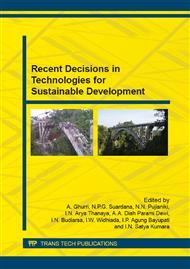p.239
p.246
p.253
p.260
p.264
p.271
p.277
p.282
p.289
Green Composites Based on Recycled Plastic Reinforced Local Sisal Fibers
Abstract:
Recycled polypropylene (PP) and sisal fiber, which are available in abundant ammount, can be used for producing a composite, a new material that reduce production costs and environmental damage. The new materials will be used for manufacturing floor tiles that are environmentally friendly, light but still technically qualified, and are expected to replace the ceramic tiles that are relatively heavy. However, the drawbacks in the application, natural fiber is a combustible material and it absorbs water easily (hydrophilic). To overcome these obstacles then a study on fiber chemical treatment was conducted. The purpose of this study is to determine the effect of chemical treatments on sisal fibers for fire resistance capability, the moisture resistance and tensile properties of the composites. So these composite materials can replace ceramic tile that is used for houses, hotels, ships and so on. In this research, sisal fibers with length of 10 mm were treated by NaOH and followed by Vulcan AF21 (Vulcan) of 5%, 10% and 20% for 2-hours for fire resistance, and other treatment with Acrylic acid (AA) of 1%, 5% and 10% for 1 hour at 50°C for moisture resistance. Fiber material that has been chemically treated is mixed with recycled PP. Test specimens were made in hot pressed. Fire resistance testing was conducted based on ASTM D635 standards, water absorption testing (ASTM D570), and tensile testing. The result shows that the higher the percentage of Vulcan treatment on sisal fiber is of 5%, 10% and 20%, the linear burning rate, the percentage of weight loss and weight loss rate of sisal fiber polypropylene composites decreases which means the composite is more resistant to fire. In general, the increase percentage of Vulcan on treatment sisal fibers shows a decrease in tensile strength and modulus of elasticity but a slight increase tensile strain of composite. Fiber treated with acrylic acid (AA) experienced a reduction of water absorption compared to the untreated of fiber composites.
Info:
Periodical:
Pages:
264-270
Citation:
Online since:
July 2015
Authors:
Keywords:
Price:
Сopyright:
© 2015 Trans Tech Publications Ltd. All Rights Reserved
Share:
Citation:


